Transferts monétaires et mobilité humaine
Les transferts monétaires sont souvent utilisés lors de crises afin de répondre aux besoins des personnes migrantes. Dans cette page, vous trouverez des ressources sur les transferts monétaires et la migration.

La Croix-Rouge se prépare à fournir une aide humanitaire aux migrant·es de la caravane sur le point de quitter le Honduras pour le Guatemala.
©Johannes Chinchilla / FICR.
Conflits, crises économiques et catastrophes sont autant de raisons ayant contraint des personnes à fuir et à traverser des frontières dans des conditions éprouvantes et risquées, en quête de sécurité et de moyens de subsistance. En 2020, le nombre de personnes déplacées de force s’est envolé au niveau sans précédent de plus de 80 millions de personnes, soit près du double du nombre enregistré il y a une dizaine d’année. Cette tendance s’aggrave et les effets du changement climatique menacent de déplacer jusqu’à 200 millions de personnes d’ici 2050.
L’assistance monétaire est de plus en plus utilisée afin de répondre aux besoins des personnes en situation de déplacement. On y a eu recours à grande échelle dans différents contextes de migration, en Europe en 2015 jusqu’au Venezuela pour « los caminantes ». Elle a également été utilisée dans d’autres crises migratoires, notamment en Amérique centrale, au Sahel, en Méditerranée et dans la Corne de l’Afrique. L’assistance monétaire est à l’heure actuelle l’une des principales formes d’aide apportée aux populations déplacées en Ukraine et dans les pays voisins.
Il existe une myriade de perspectives et de définitions concernant le mot « migrant·e » et la façon dont les humanitaires doivent agir. C’est pourquoi nous ne choisissons pas une définition unique pour le moment, étant donné que les discussions sur l’assistance monétaire et la migration en sont encore à leurs prémices et que le langage évolue encore.
Documenter et partager les données probantes donnera lieu à des interventions plus efficaces. Cette page contient une sélection de ressources utiles concernant la migration et le recours à l’assistance monétaire. Elle sera mise à jour au fil des discussions ayant lieu dans les espaces humanitaires des transferts monétaires.
Priorités actuelles
Afin de contribuer aux progrès relatifs à cet enjeu, nous nous engageons à :
- soutenir la création de données probantes aux niveaux régional et mondial ;
- contribuer aux solutions pratiques visant à mettre en œuvre les transferts monétaires auprès des personnes migrantes ;
- organiser des discussions sur les enjeux majeurs basées sur des données probantes.
Contenu récent

Les Transferts d’Argent par Téléphonie Mobile et par IMF pour les Réfugiés Urbains à Niamey (Niger)
Rapport
Cette étude a comparé l’efficacité des transferts d’argent par téléphonie mobile et les transferts de cash par l’Institution de Micro-Finance aux réfugiés urbains à Niamey. L’étude a révélé que le mécanisme de transfert d’argent par téléphonie mobile serait plus rentable que le...
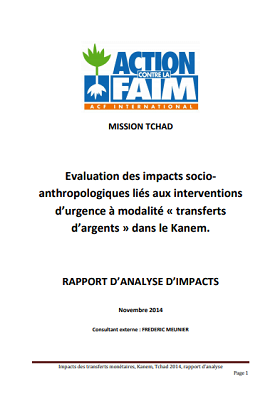
Évaluation des impacts socio-anthropologiques liés aux interventions d’urgence à modalité « transferts d’argents » dans le Kanem – Rapport d’analyse d’impact
Rapport
Ce rapport reflète les constats perçus par l’évaluateur externe sur les impacts des actions de transferts monétaires sans contrepartie dans la région du Kanem et dans le cadre existant des projets en 2014. Les mesures de mitigations des impacts négatifs sont formulées dans le cadre de la...
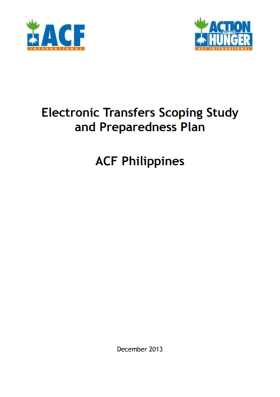
Electronic Transfers Scoping Study and Preparedness Plan
Policy paper
This piece of work was arranged by Action Against Hunger (ACF), with the intention of understanding the electronic payment services available in a minimum of two country missions and to support ACF in preparing for future humanitarian response in country and globally, with a specific focus on...
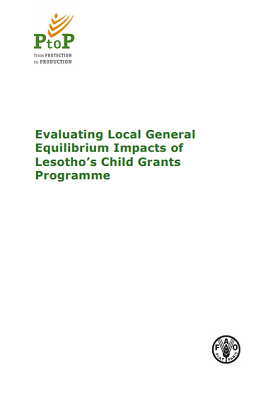
Evaluating Local General Equilibrium Impacts of Lesotho’s Child Grants Programme
Report
This report presents findings from a local economy-wide impact evaluation (LEWIE) of Lesotho’s Child Grants Programme. Simulations indicate that total income impacts significantly exceed the amounts transferred under the programme: each loti transferred stimulates local nominal income gains of up to...
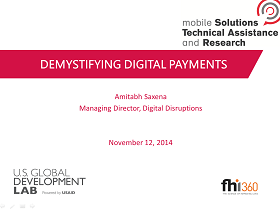
Demystifying Payments – mStar
Report
In its simplest form, a payment is any exchange of value between two parties, where usually Party A offers a form of currency in exchange for a good or service provided by Party B. The advent of nation-states issuing fiat currency, such as paper bills and bronze coins, which unlike gold or silver...
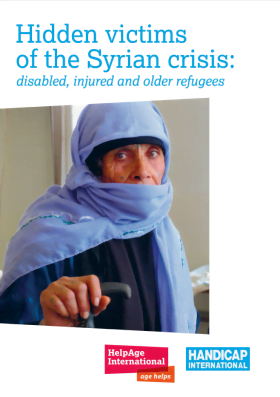
Hidden Victims of the Syrian Crisis: Disabled, injured and older refugees
Report
The Syrian crisis has generated the largest refugee movement since the Rwandan genocide and is described as the defining refugee crisis of our era. According to the United Nations High Commissioner for Refugees, Antonio Guterres, Syrian refugees are about to replace Afghans as the world’s largest...

Support to the local tool market post-Typhoon Haiyan
Report
Super Typhoon Haiyan struck Leyte and Eastern Samar in the Philippines in November 2013. CRS responded by initiating a program in 2014 to support the livelihoods recovery of 5,250 agriculture-based households. The Livelihood Early Recovery Support to Agricultural Households Affected by Typhoon Yolanda...
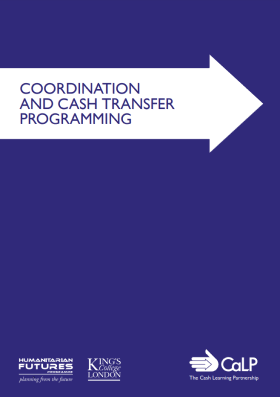
Coordination and Cash Transfer Programming
Policy paper
This thematic report has been undertaken as part of a 2013 research study entitled, Is Cash Transfer Programming ‘Fit for the Future’? The research was commissioned by the the CALP Network and undertaken by the Humanitarian Futures Programme (HFP), King’s College London. The overall...
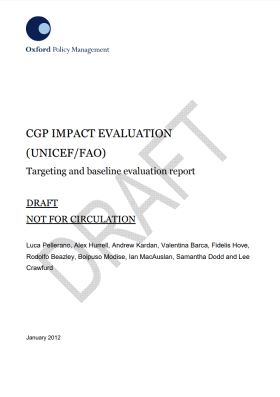
CGP Impact Evaluation (UNICEF/FAO): Targeting and baseline evaluation report
Report
The Child Grants Programme (CGP) is an unconditional cash transfer targeted to poor and vulnerable households in Lesotho. The primary objective of the CGP is to improve the living standards of Orphans and Vulnerable Children (OVC) so as to reduce malnutrition, improve health status, and increase school...
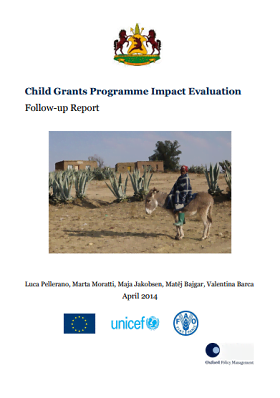
Child Grants Programme Impact Evaluation Follow-up Report
Report
The Lesotho Child Grants Programme (CGP) is an unconditional social cash transfer targeted to poor and vulnerable households. It provides every quarter a regular transfer of between M360 and M7501 to poor households with children that are selected through a combination of Proxy Means Testing (PMT) and...

A Double-edged Sword: Livelihoods in emergencies guidance and tools for improved programming
Guidelines and Tools
This document aims to help economic development practitioners who design economic strengthening projects with the particular aim of improving child wellbeing and for others whose aim is poverty alleviation more broadly. The guidance presented is based on the understanding that: 1. Household economic...

Les outils du CALP Network: vue d’ensemble
Guides et outils
Ce document présente les principaux outils développés par le CALP Network afin de soutenir la communauté de pratique dans l’apprentissage, le partage d’informations et les discussions sur des sujets relatifs aux transferts monétaires.

Evaluation des impacts socio-anthropologiques liés aux interventions d’urgence à modalité « transferts d’argents » dans le Kanem – Rapport d’orientations stratégiques
Rapport
Ce rapport donne des orientations stratégiques et programmatiques ainsi que des recommandations sur les évolutions des programmes de transferts monétaires non conditionnées dans la région du Kanem. Il se base sur une analyse des ressources locales, des liens externes à la région, des positions des...
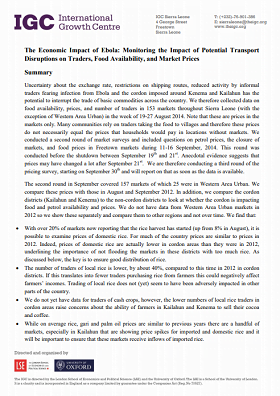
The Economic Impact of Ebola: Monitoring the Impact of Potential Transport Disruptions on Traders, Food Availability, and Market Prices
Report
Uncertainty about the exchange rate, restrictions on shipping routes, reduced activity by informal traders fearing infection from Ebola and the cordon imposed around Kenema and Kailahun has the potential to interrupt the trade of basic commodities across the country. We therefore collected data on food...
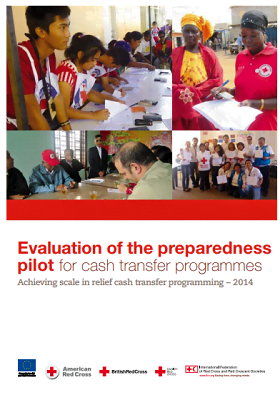
Evaluation of the preparedness pilot for cash transfer programmes – Achieving scale in relief cash transfer programming – 2014
Report
It is recognized that cash transfer programming can be effective in supporting populations affected by disasters in a way that maintains dignity and choice for beneficiaries while stimulating local livelihoods, economies and markets. However, the majority of cash transfer programming has been undertaken...

Les transferts monétaires dans les situations d’urgence urbaine – Boîte à outils destinées aux praticiens
Guides et outils
Reconnaissant la croissance de la population urbaine dans le monde et leur vulnérabilité croissante aux catastrophes, le CALP Network se propose d’examiner l’état actuel et l’impact des programmes d’intervention en milieu urbain faisant appel aux transferts monétaires. Cette étude vise...
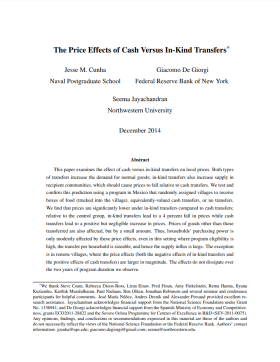
The Price Effects of Cash Versus In-Kind Transfers
Report
This paper examines the effect of cash versus in-kind transfers on local prices. Both types of transfers increase the demand for normal goods; in-kind transfers also increase supply in recipient communities, which should cause prices to fall relative to cash transfers. We test and confirm this prediction...

Financing of Cash Transfer Programming
Policy paper
This thematic report has been undertaken as part of a 2013 research study entitled, Is Cash Transfer Programming ‘Fit for the Future’? The research was commissioned by the the CALP Network and undertaken by the Humanitarian Futures Programme (HFP), King’s College London. The overall...

Sector Indicator Guidance for Programming
Guidelines and Tools
The country Programming Instructions that were sent to EU Delegations and HQ services in mid-May 2012 for the programming period 2014-2020, requested the EU Delegations and services to provide, in the second phase of the programming process, a description of specific objectives for proposed priority...
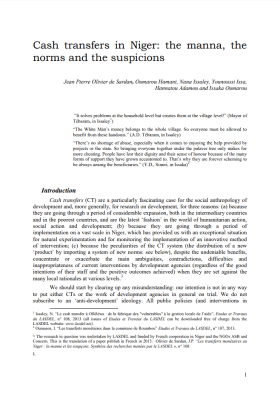
Cash transfers in Niger: The manna, the norms and the suspicions
Report
Cash transfers (CT) are a particularly fascinating case for the social anthropology of development and, more generally, for research on development, for three reasons: (a) because they are going through a period of considerable expansion, both in the intermediary countries and in the poorest countries,...